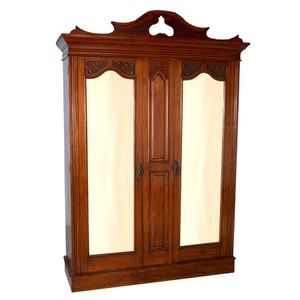Colonial Native Woods Wardrobe with Arched Doors and Lattice Panel
You must be a subscriber, and be logged in to view price and dealer details.
Subscribe Now to view actual auction price for this item
When you subscribe, you have the option of setting the currency in which to display prices to $Au, $US, $NZ or Stg.
- Pediment - The uppermost section of a tall usually double-heightened piece of cabinet furniture, surmounting the cornice. The pediment can take a variety of forms derived from the architecture of classical antiquity. A broken pediment is of triangular shape, however, the two raised sides do not meet at the apex but are 'broken' the gap between them often ornamented with an urn or finial. Swan-neck pediments are of similar form, although the uprights are gracefully arched, resembling a swan's neck. They are often found, for example, on longcase clocks.
- Plinth - The square or rectangular base of a piece of cabinet furniture, often ornamented with moulding. The plinth may be separate, as in some wardrobes or presses, and act as the support for the carcase. In a false plinth, the moulded boards may be attached directly to the piece. Furniture with a plinth base usually does not have separate feet. The term derives from architecture where it denotes the base of a column or statue.
This item has been included into following indexes:
Visually similar items

Australian cedar break front 4 door robe, with unusual selected cuts of butt cedar veneer, circa 1820/30s. See Fahy & Simpson, Australian Furniture Pictorial History and Dictionary, 1788-1938 (plate 574). Note: Originally attributed as 1850s we now believe

Anthony Hordern & Sons Queensland maple wardrobe early 20th century, with keys, brass makers plaque inside door, 236 cm high, 164 cm long, 56.5 cm deep

Cedar wardrobe, Victorian with three panelled doors, centred with a mirror, height 215 length 190 depth 55 cm

A Huon pine campaign wardrobe, circa 1890, 210 cm high, 162 cm wide, 60 cm deep
